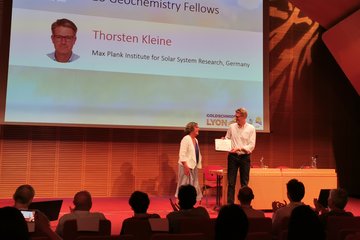Alle Typen
41.
Zeitschriftenartikel
Increased concentration and vertical distribution of carbon dioxide in the stratosphere. Nature 316, S. 135 - 136 (1985)
42.
Zeitschriftenartikel
The vertical distribution of CHCLF2 (CFC-22) in the stratosphere. Geophysical Research Letters 12, S. 1 - 3 (1985)
43.
Zeitschriftenartikel
The vertical distribution of CFC-114 in the atmosphere. Journal Geophysical Research 90, S. 13091 - 13093 (1985)
44.
Zeitschriftenartikel
Increasing abundance of CBrClF2 in the atmosphere. Nature 316, S. 135 - 136 (1985)
45.
Zeitschriftenartikel
Vertical profiles of halocarbons in the stratosphere. Advances in Space Research 4, S. 135 - 138 (1984)
46.
Zeitschriftenartikel
Trace gas measurements during aircraft flights in the tropopause region over Europe and North Africa. J. Atmos. Chem. 2, S. 133 - 143 (1984)
47.
Zeitschriftenartikel
First measurements of the vertical distribution of CCl4 and CH3CCl3 in the stratosphere. Naturwissenschaften 10, S. 14 - 16 (1983)
48.
Zeitschriftenartikel
The vertical distribution of stable trace gases at midlatitudes. Journal Geophysical Research 86, S. 5179 - 5184 (1981)
49.
Zeitschriftenartikel
Halocarbons in the stratosphere. Nature 294, S. 733 - 735 (1981)
50.
Zeitschriftenartikel
Decrease in CO2 mixing ratio observed in the stratosphere. Nature 288, S. 347 - 348 (1980)
51.
Zeitschriftenartikel
Methyl chloride in the stratosphere. Nature 283, S. 58 - 60 (1980)
52.
Zeitschriftenartikel
Simultaneously measured vertical profiles of H2, CH4, CO, N2O, CFCl3 and CF2Cl2 in the midlatitude stratosphere and troposphere. Journal Geophysical Research 84, S. 3149 - 3154 (1979)
53.
Zeitschriftenartikel
Results of conductivity, ion mobility and ion concentration measurements obtained with a parachutet Gerdien aspiration analyses probe in heights below 70 km. Journal of Atmospheric and Terrestrial Physics 41, S. 1141 - 1147 (1979)
54.
Zeitschriftenartikel
Payload BIII - an instrument package for the measurement of conductivity, concentration an mobility of positive and negative ions in the meosphere. J. Geophys. 44, S. 179 - 188 (1977)
55.
Zeitschriftenartikel
Experimental results on the variation of electric conductivity an ion mobility in the mesosphere. Journal Geophysical Research 81, S. 6217 - 6220 (1976)
56.
Zeitschriftenartikel
Ergebnisse von Ionendichte- und Ionenbeweglichkeitsmessungen mit einer Fallschirmsonde im Höhenbereich von 72 bis 39 km. Kleinheubacher Berichte 14, S. 255 - 262 (1971)
57.
Zeitschriftenartikel
A mesosphere payload to measure the concentration and mobility of positive and negative ions in the height range between 72 and 40 km. J. Brit. Interpl. Soc. 24, S. 215 - 231 (1971)
58.
Zeitschriftenartikel
Results of concentration and mobility measurements of positively and negatively charged particles taken by a rocket-borne parachutet aspiration (Gerdien) probe in the height region from 72 to 39 km. Pageoph 84, S. 154 - 160 (1971)
59.
Buchkapitel
Individual contribution of participant no. In: ``The partitioning of ClOy in the stratosphere'', Final report to the European Commission on CEC Contract EV5V-CT93-0346, S. 93 - 115 (Hg. Camy-Peyret, C.). European Commission, Paris (1996)
60.
Buchkapitel
Results of conductivity, ion mobility and ion concentration measurements taken with a parachute Gerdien Kondensor experiment during the winter anomaly campaign. In: COSPAR Space Res., S. 125 - 127 (Hg. Rycroft, M. J.; Stickland, A. C.). Pergamon Press Oxford (1978)











